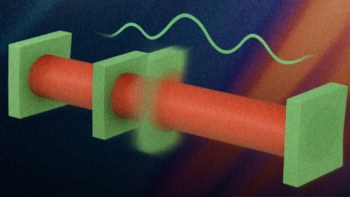
Disorder, or entropy, in a microscopic quantum system has been measured by an international group of physicists. The team hopes that the feat will shed light on the “arrow of time”: the observation that time always marches towards the future. The experiment involved continually flipping the spin of carbon atoms with an oscillating magnetic field and links the emergence of the arrow of time to quantum fluctuations between one atomic spin state and another.
“That is why we remember yesterday and not tomorrow,” explains group member Roberto Serra, a physicist specializing in quantum information at the Federal University of ABC in Santo André, Brazil. At the fundamental level, he says, quantum fluctuations are involved in the asymmetry of time.
Egging on
The arrow of time is often taken for granted in the everyday world. We see an egg breaking, for example, yet we never see the yolk, white and shell fragments come back together again to recreate the egg. It seems obvious that the laws of nature should not be reversible, yet there is nothing in the underlying physics to say so. The dynamical equations of an egg breaking run just as well forwards as they do backwards.
Entropy, however, provides a window onto the arrow of time. Most eggs look alike, but a broken egg can take on any number of forms: it could be neatly cracked open, scrambled, splattered all over a pavement, and so on. A broken egg is a disordered state – that is, a state of greater entropy – and because there are many more disordered than ordered states, it is more likely for a system to progress towards disorder than order.
This probabilistic reasoning is encapsulated in the second law of thermodynamics, which states that the entropy of a closed system always increases over time. According to the second law, time cannot suddenly go backwards because this would require entropy to decrease. It is a convincing argument for a complex system made up of a great many interacting particles, like an egg, but what about a system composed of just one particle?
Murky territory
Serra and colleagues have delved into this murky territory with measurements of entropy in an ensemble of carbon-13 atoms contained in a sample of liquid chloroform. Although the sample contained roughly a trillion chloroform molecules, the non-interacting quantum nature of the molecules meant that the experiment was equivalent to performing the same measurement on a single carbon atom, one trillion times.
Serra and colleagues applied an oscillating external magnetic field to the sample, which continually flipped the spin state of a carbon atom between up and down. They ramped up the intensity of the field oscillations to increase the frequency of the spin-flipping, and then brought the intensity back down again.
Had the system been reversible, the overall distribution of carbon spin states would have been the same at the end as at the start of the process. Using nuclear magnetic resonance and quantum-state tomography, however, Serra and colleagues measured an increase in disorder among the final spins. Because of the quantum nature of the system, this was equivalent to an increase in entropy in a single carbon atom.
”It’s easier to dance to a slow rhythm than a fast one” Roberto Serra, Federal University of ABC
According to the researchers, entropy rises for a single atom because of the speed with which it is forced to flip its spin. Unable to keep up with the field-oscillation intensity, the atom begins to fluctuate randomly, like an inexperienced dancer failing to keep pace with up-tempo music. “It’s easier to dance to a slow rhythm than a fast one,” says Serra.
Many questions remain
The group has managed to observe the existence of the arrow of time in a quantum system, says experimentalist Mark Raizen of the University of Texas at Austin in the US, who has also studied irreversibility in quantum systems. But Raizen stresses that the group has not observed the “onset” of the arrow of time. “This [study] does not close the book on our understanding of the arrow of time, and many questions remain,” he adds.
One of those questions is whether the arrow of time is linked to quantum entanglement – the phenomenon whereby two particles exhibit instantaneous correlations with each other, even when separated by vast distances. This idea is nearly 30 years old and has enjoyed a recent resurgence in popularity. However, this link is less to do with growing entropy and more to do with an unstoppable dispersion of quantum information.
Indeed, Serra believes that by harnessing quantum entanglement, it may even be possible to reverse the arrow of time in a microscopic system. “We’re working on it,” he says. “In the next generation of our experiments on quantum thermodynamics we will explore such aspects.”
The research is described in Physical Review Letters.
- What is time? was chosen by Physics World editors as one of the five biggest unanswered questions in physics. In the 25th anniversary issue of the magazine (published in 2013) Adam Frank chronicles what we know and don’t know about the mysterious fourth dimension



